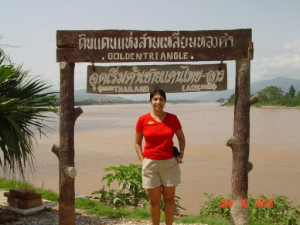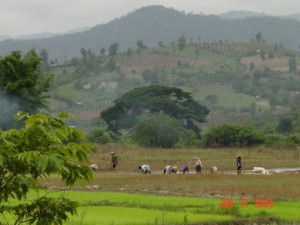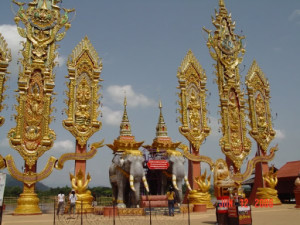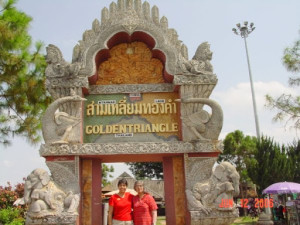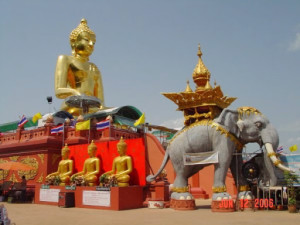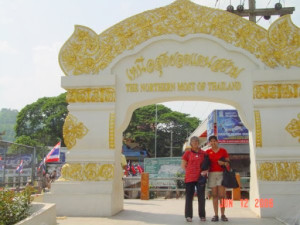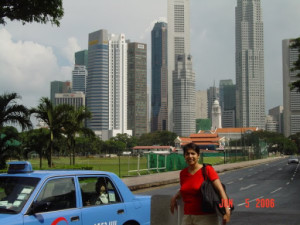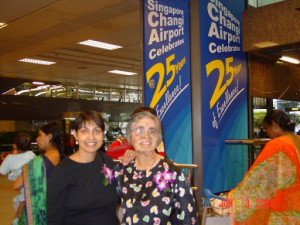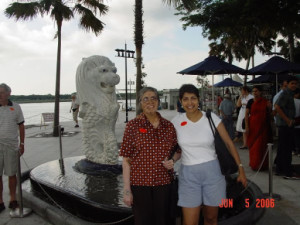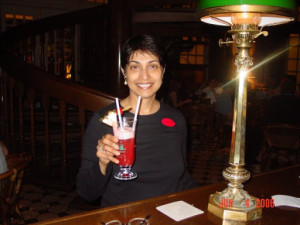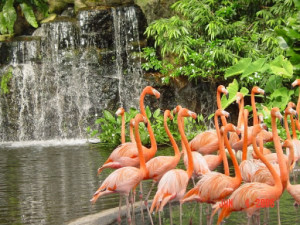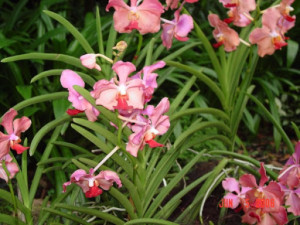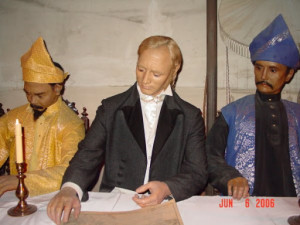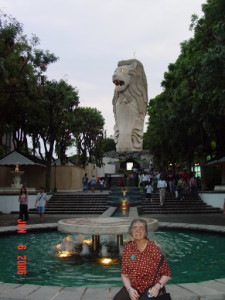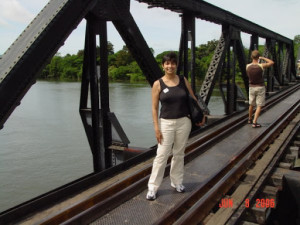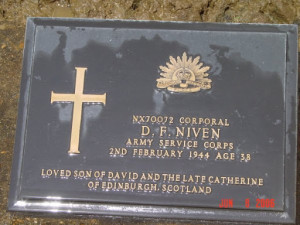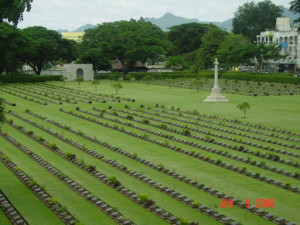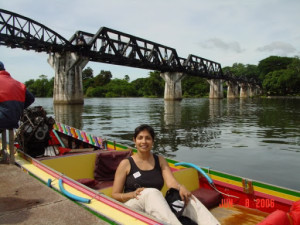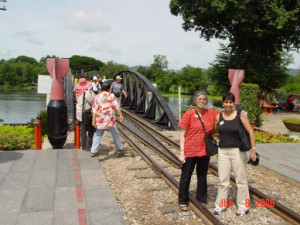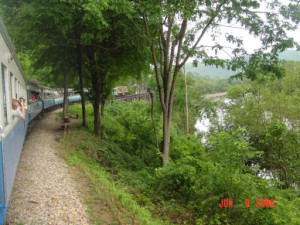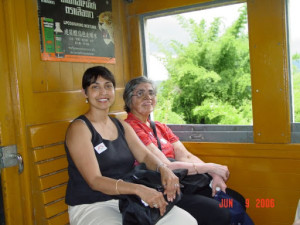
Our next stop was Bangkok, capital of Thailand, a country that we found in a state of jubilation over the celebrations for the 60th anniversary of the coronation of their beloved King Bhumibol Adulyadej. Indeed the entire nation sported the national color—yellow–on T-shirts that had been specially designed for the occasion with the royal emblem—the Chakri—emblazoned on the pocket. Monarchs from every part of the planet had descended upon Bangkok to participate in the royal pageantry that included a candle-lighting ceremony by the future heir to the throne, a procession of royal barges on the Chao Praya River that meanders through the city and a succession of formal dinners and tours for the visiting dignitaries. The downside of all this pomp and splendor was that many of our tours around the city were cancelled as roads were closed for security reasons. However, we did get to see Bangkok in a wildly festive mood with illuminations decorating every monument and massive cutout figures of the King punctuating every street corner resplendent with yellow banners and flowers. We were also very fortunate to catch a glimpse of the rehearsal ceremony on the river with the royal barges skimming over it as we crossed the very modern Rama IX Bridge that spans the two halves of the city.

But royal festivity aside, Bangkok offers a great deal to the visitor eager to become acquainted with its centuries-old history and culture. We saw innumerable Wats or Buddhist temple complexes that house a chedi or stupa—a conical structure that is solid or hollow if it contains a sacred relic of the Buddha—a wihan or assembly hall for the faithful to join in community prayer, a bot or audience hall where the most revered statues are kept, and a series of cloisters or border walls that keep the sacred space removed from the secular world outside.

Two of Bangkok’s most famous wats are Wat Traimit where we saw the world’s most massive Buddha cast in pure solid gold (left) in the thirteenth century, then disguised under a thick camouflage of plaster to protect it from the Burmese invasion and discovered for its true value only in 1957 when chunks of plaster began to wear away and fall off to reveal the extraordinary statue concealed within.

At Wat Pho, we saw a colossal Reclining Buddha, so immense that it actually took my breath away even though I was prepared for its stupendous dimensions.
Every Wat is an amazing achievement of architectural and artistic beauty with glass, ceramic, gilded and sculpted decoration that is truly breathtaking. What is most heartening, however, is the fact that these fantastic structures are not just historical wonders but vibrant places of contemporary worship in which devout Buddhists daily express their faith in God through the application of real gold leaf to the idols and deities within, in order to “gain merit”. We saw countless Thais make offerings to the monks who received them with gratitude and humility, buy lotus buds and flowers as presents to the wat as they moved in slow procession around its precincts and bend low in the presence of their priests who patted them on their heads while offering their blessings. In every wat, we watched in silence as the faithful prostrated themselves before the statues of the Buddha. Clearly, the clergy and the elderly are held in very special esteem in this society and it was quite moving to see the manner in which these people have continued to adhere to an ancient religion while making every attempt to move with the times.
Indeed, visits to gem factories where Thailand’s famous sapphires and rubies are cut and set into jewelry, gave us a glimpse into the commercial side of Bangkok, a side that also manifests itself in the sleazy activities of hookers, the proliferation of “massage parlors” outside which girls hung out while luring customers in and in the mad shopping frenzy in places like Mahboonkrong (MBK) Mall and Indra Market where the bargains abounded. It was quite astonishing to see the age-old tuktuk or auto rickshaw coexist in crazy harmony with the very modern SkyTrain (in both of which we “commuted”) that skims the city on tracks built high above Bangkok’s proverbially chaotic traffic. Though the streets are spotlessly clean and traffic moves in a disciplined manner sans blaring horns (unlike India), there were many stray dogs lurking around.
 As if to offer some respite from its seedy side, one of Bangkok’s most fascinating attractions in Jim Thompson’s House (left). This serene complex of six traditional Thai teak houses positioned around a gravel courtyard and lovingly maintained tropical gardens should be a must on every tourist itinerary. I was glad to visit in the late evening while the sun was setting gently and casting lengthening shadows upon the nooks and crannies of this delightful abode built on the riverbanks. The house was once the residence of American-born James Thompson, a Princeton-educated architect, who was stationed in Thailand during World War II. He fell in love with the country and its people and decided to make Thailand his home. On seeing the ills that had afflicted Thailand’s silk weaving industry, Thompson decided to revive it and, within a few years, had created a gigantic business enterprise that made him his fortune while reviving one of the country’s most ancient crafts. Thompson spent his money on the acquisition of Asian antiquities in the form of precious old Buddhas, blue and white porcelain, hand carved teak furniture, jataka paintings that depict the story of the Buddha’s life, etc. As we moved from room to room decorated tastefully in a style that combined Eastern elements (such as low floor seating covered by silk cushions) with Western ones (such as the use of crystal chandeliers and table lamps for ambient lighting), I was struck by his exquisite taste and style and felt saddened to learn that he disappeared one day at the age of 61 while taking a hike in the Cameroon Highlands of Malaysia while on vacation. Wonderful silk gift and souvenir items are available in the store that is part of the complex. Though terribly overpriced (in my opinion), they were quite unique and very tastefully designed.
As if to offer some respite from its seedy side, one of Bangkok’s most fascinating attractions in Jim Thompson’s House (left). This serene complex of six traditional Thai teak houses positioned around a gravel courtyard and lovingly maintained tropical gardens should be a must on every tourist itinerary. I was glad to visit in the late evening while the sun was setting gently and casting lengthening shadows upon the nooks and crannies of this delightful abode built on the riverbanks. The house was once the residence of American-born James Thompson, a Princeton-educated architect, who was stationed in Thailand during World War II. He fell in love with the country and its people and decided to make Thailand his home. On seeing the ills that had afflicted Thailand’s silk weaving industry, Thompson decided to revive it and, within a few years, had created a gigantic business enterprise that made him his fortune while reviving one of the country’s most ancient crafts. Thompson spent his money on the acquisition of Asian antiquities in the form of precious old Buddhas, blue and white porcelain, hand carved teak furniture, jataka paintings that depict the story of the Buddha’s life, etc. As we moved from room to room decorated tastefully in a style that combined Eastern elements (such as low floor seating covered by silk cushions) with Western ones (such as the use of crystal chandeliers and table lamps for ambient lighting), I was struck by his exquisite taste and style and felt saddened to learn that he disappeared one day at the age of 61 while taking a hike in the Cameroon Highlands of Malaysia while on vacation. Wonderful silk gift and souvenir items are available in the store that is part of the complex. Though terribly overpriced (in my opinion), they were quite unique and very tastefully designed.
 Our hotel, Ambassador Towers, was located in the bustling heart of Sukhumvit, an area that has mushroomed in recent years and that caters exclusively to the Western tourist. A plethora of restaurants exists in this well laid out grid of narrow streets, tourist bric-a-brac is cheaply available and services catering to the needs of foreign travelers, such as photography outfits and Internet cafes, abound. The negative side of such convenience is open flesh trading and as someone involved in Women’s Studies, I was disheartened to see scores of painfully young Thai women on the arms of old, often disabled, white men, only in Bangkok to partake of its easily available sexual pleasures. On talking to a few educated Thai female tourist guides about this social evil, I discovered that most of Bangkok’s prostitutes are the daughters of prostitutes themselves. Indeed, most are single mothers with little children who will also find their way, ultimately, as sex workers in the world’s most notorious brothel.
Our hotel, Ambassador Towers, was located in the bustling heart of Sukhumvit, an area that has mushroomed in recent years and that caters exclusively to the Western tourist. A plethora of restaurants exists in this well laid out grid of narrow streets, tourist bric-a-brac is cheaply available and services catering to the needs of foreign travelers, such as photography outfits and Internet cafes, abound. The negative side of such convenience is open flesh trading and as someone involved in Women’s Studies, I was disheartened to see scores of painfully young Thai women on the arms of old, often disabled, white men, only in Bangkok to partake of its easily available sexual pleasures. On talking to a few educated Thai female tourist guides about this social evil, I discovered that most of Bangkok’s prostitutes are the daughters of prostitutes themselves. Indeed, most are single mothers with little children who will also find their way, ultimately, as sex workers in the world’s most notorious brothel.
Though it was discomforting to find ourselves surrounded by Bangkok’s infamous carnal trade, I was grateful for the fact that the innumerable local restaurants allowed us to sample the best of Thailand’s famed cuisine in very modest eateries that offered home-cooked meals for almost no money at all. We feasted on Tom Yum Goong (Hot and Sour Prawn Soup), Tom Kai Gha (Chicken Coconut Milk Soup), Pad Thai (Thai-Style Noodles), and a variety of curries all served on steamed rice. Dessert is always fresh fruit and we spent a delightful morning at a roadside fruit stall tasting a number of rather unusual fruits such as rambutans, lichis, mangosteens, longons, durians, dragon fruit and guavas which abounded in market stalls and on our hotel buffet menus together with the more familiar papayas, pineapples and watermelons.
 The Diamond Jubilee celebrations prevented us from visiting the Royal Palace and Wat Phra Keo which houses the most revered statue in all of Thailand, the Emerald Buddha. We could not visit the National Museum, the Old Farang Quarter where Bangkok’s famous Oriental Hotel is located or Dusit Park which contains Vimanmek Palace. All of these restrictions lead me to believe that though I did not care much for the city, on the whole, perhaps I am destined at some future time in my life, to visit this city again! For the most part, however, I was happy to leave Bangkok behind and take the day-long excursion to Kanchanaburi, a small town on the Thailand-Burma border.
The Diamond Jubilee celebrations prevented us from visiting the Royal Palace and Wat Phra Keo which houses the most revered statue in all of Thailand, the Emerald Buddha. We could not visit the National Museum, the Old Farang Quarter where Bangkok’s famous Oriental Hotel is located or Dusit Park which contains Vimanmek Palace. All of these restrictions lead me to believe that though I did not care much for the city, on the whole, perhaps I am destined at some future time in my life, to visit this city again! For the most part, however, I was happy to leave Bangkok behind and take the day-long excursion to Kanchanaburi, a small town on the Thailand-Burma border.
Bon Voyage!
